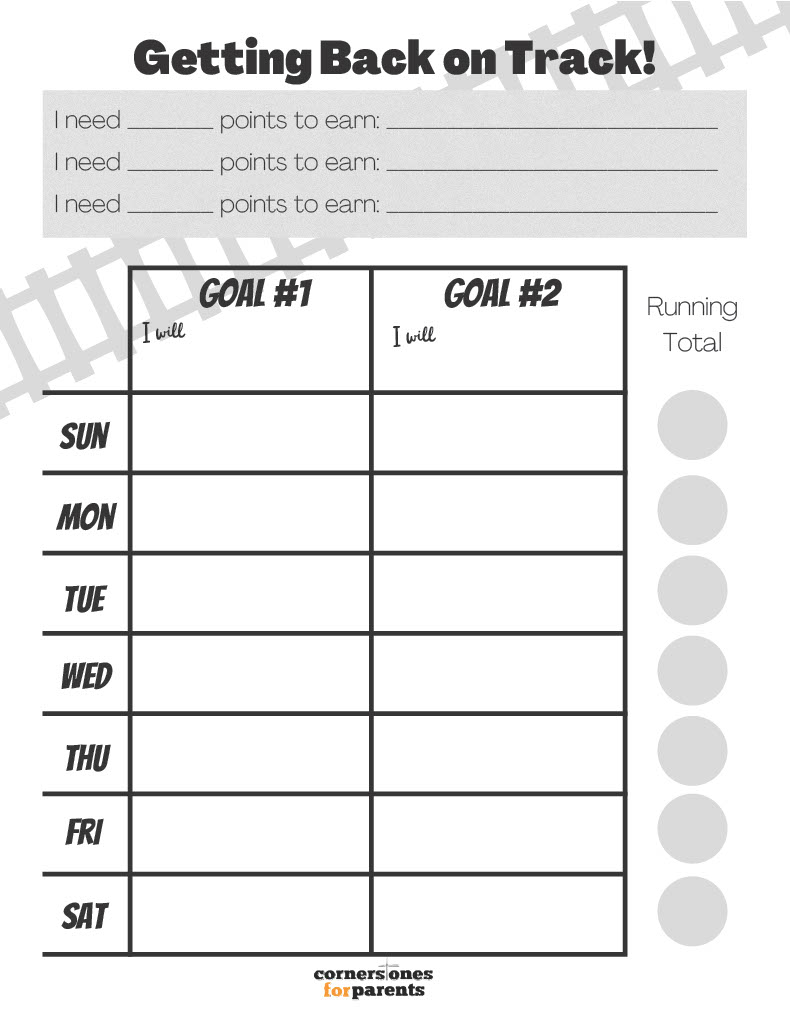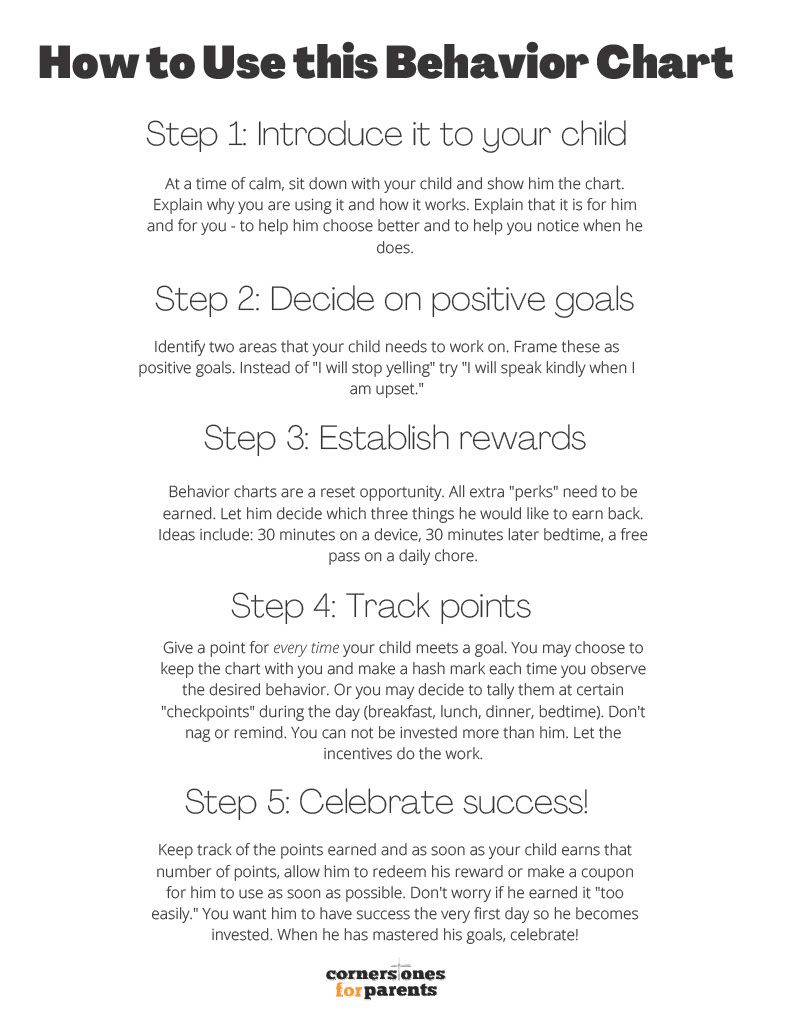Sometimes kids need a reset. Negative behavior patterns can become entrenched and the whole family system can feel “off.” If your child is in a really negative place and all of your efforts to correct feel ineffective, a behavior chart may be just the thing your family needs to make a shift.
Behavior charts are not long-term solutions to behavior problems. They are a temporary tool to help you break into a cycle of misbehavior.
This particular type of behavior chart is as much for you as it is for your child. It will help you to focus more on the positive instead of the negative.
[NOTE: This chart is best used with readers, but can be modified to be used with pre-readers using smiley face stickers for points and images instead of words to depict goals]Here are some behaviors that would warrant the use of a behavior chart “reset:”
- regular outright defiance towards authority
- verbal abuse of others
- physical aggression towards others
- ongoing patterns of misbehavior that are not helped by other forms of discipline
- anger and defiance that are not addressed by other interventions
NEW and Improved FREE PRINTABLE (click image to download)
Step 1: Introduce the behavior chart
At a time of peace, sit down with your child and introduce the chart. Explain how it works and that it is for both of you. You may struggle to find a time of peace given the circumstances that warrant a behavior chart, but be sure to check your heart. You want to approach your child when you can access compassion and grace so you can present it, not as a punishment, but as a resource for you both.
Step 2: Decide on positive goals
Identify two areas in which your child is struggling. There may be many more, but start with two and not necessarily the most challenging areas. You want your child to experience success with the chart early in its implementation, so establish accessible goals.
You want to frame the goals in the form of what you want to see more of rather than what you are trying to eliminate. For example, if your son screams at others when angry or upset, a positively framed goal would be “I will use kind words when I am angry” or “I will use my cool-down techniques when I am frustrated with others.” If his goals include the use of a new skill, be sure that he is well-equipped to use it. Here are some more examples:
- I will respect other people’s space
- I will give gentle touches to my sister
- I will share with my brother
- I will count down from 5 and squeeze my fists when I want to use a bad word
- I will calmly ask my mom ONE TIME for 5 more minutes before a transition
Step 3: Establish rewards
This is very child-specific. If your child has been in a difficult place for some time, you have likely removed some privileges already. You can use those as the incentive with this chart. Help your child determine which three things he would like to work to earn back. Here are some examples of what your child might work for during the week:
- 30 minutes on a device
- A free pass on a undesired daily chore
- Quick outing with a parent
- A small gift (you can buy a few items at the dollar store and let him “shop”)
Remember, you are not dangling a carrot in front of your child hoping that he will bite. You are handing the reins to him: he is in control of what rewards he will get to enjoy. This is one of the key steps in the chart being successful. You cannot be more invested in the outcome than he is.
You will also need to pre-determine how many points your child will need to earn in order to redeem his rewards. Try to set it up so that at least one reward is achievable in the first day. This will help hook your child into the program and increase compliance.
Step 4: Track points
You have two choices. You can:
A) give a point every time your child engages in the desirable behavior (with no ceiling on daily points). Hash marks work well here.
B) tally points at certain check points during the day (breakfast, lunch, dinner, bedtime). This option is better for older kids and you can engage with a “review” of their morning/afternoon/night together.
Step 5: Celebrate success!
As your child collects points, be sure to offer him his reward as soon as it is earned. If you are unable to reasonably do it at the time it was earned, provide him with a coupon that he can redeem later. Do not take that coupon away even if a misbehavior happens in between. You are focused on rewarding what you want to see more of, and he earned it even if he struggled later.
Step 6: Re-evaluate
You may find that your child begins to show improvement in a certain area very quickly. You can replace any obsolete goals with new ones if you wish or you can celebrate his success and leave that category blank. However if you notice that one area is consistently void of points (such as respecting others), you may want to give that category a star. Any starred goal will need at least one point a day in order for the child to redeem any of his points that day.
As stated at the outset, behavior charts are not a long-term solution. They are a short-term measure for a cluster of difficult behaviors with the goal of “resetting.” Making sure that you verbally recognize the ways in which you see your child manifesting a changed heart is a great way to ensure that these improved behaviors will stick.
See also . . .






When can I start using this chart? At what age can I child start participating in this?
Hi Arely – That is a great question. Depending on how you use this chart it can be used with very young children (as young as age 3 or 4) all they way up through the teen years.
For very young children, I would not use points, but small smiley face stickers like these. You would simply put the number of smiley face stickers in the blank for the weekly goals (instead of writing in the number of points) and say, “You need this many smiley faces a day to earn ________.”(draw what they are working towards on the blank). And instead of writing the goal on the left of the chart, you can draw of picture of the desired behavior (or a symbol that you both know represents it).
I have been working on a similar chart designed specifically for younger kids and will add it to the collection when it is completed.
I hope that helps!
Laura